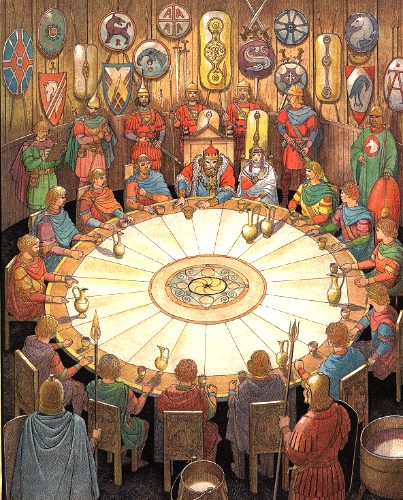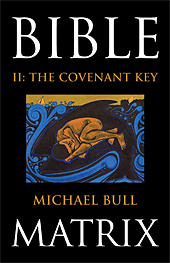Mar
28
2012
 “When Jesus stood at the door and knocked, He was the Covenant sheriff knocking on the Covenant door through His Covenant prophets to serve Covenant papers on the Covenant-breakers.”
“When Jesus stood at the door and knocked, He was the Covenant sheriff knocking on the Covenant door through His Covenant prophets to serve Covenant papers on the Covenant-breakers.”
A friend’s colleague recently posted a summary of wrong ways that evangelicals read the Bible, based on a chapter in Graeme Goldsworthy’s book, Gospel-Centred Hermeneutics. [1]
Boiled down even further, the main errors are:
- The “me-centred” approach: Context is meaningless. Texts speak directly to me.
- Literalism: Fulfilment in Jesus is ignored.
- Legalism: We rail about keeping the Sabbath but eat prawns.
- Subjectivisim: My reading of a passage is right because I felt a peace from God.
- Pluralism: The Bible has many possible interpretations.
- Pragmatism: There are more people at church, so what we are doing must be right, regardless of what the Bible says.
This is a good list, but simply dividing the Bible into pre-gospel and gospel leads to a misinterpretation of much biblical prophecy. Mr Goldsworthy’s blanket-style “everything is fulfilled in Jesus” hermeneutic means he himself ends up with a “me-centred” approach to the Bible.
Continue reading
Comments Off | tags: Covenant curse, Covenant Theology, Evangelicalism, Graeme Goldsworthy, Hermeneutics, James Jordan, Revelation | posted in Biblical Theology, Quotes, The Last Days, The Restoration Era
Mar
16
2012
 Douglas Wilson writes:
Douglas Wilson writes:
“What is the meaning of ”one is taken and the other left’? This is commonly thought to refer to the rapture — one taken up into heaven, and the other left on earth to kick himself for not praying the sinner’s prayer when he had a chance. On the bright side, there will be a lot of free, unmanned cars available” (Heaven Misplaced, p. 104).
Matthew 24 is a prediction of the Covenant curses falling upon Judah for the last time. One being taken and the other left has to do with displacement. Titus enslaved the best Jews and took them in ships to Egypt.
“And the Lord will take you back to Egypt in ships, by the way of which I said to you, ‘You shall never see it again.’ And there you shall be offered for sale to your enemies as male and female slaves, but no one will buy you.” (Deuteronomy 28:68)
It’s one thing to get the historical fulfilment correct, but there’s a whole lot more going on here. In His speech, as the fulfilment of Israel, Jesus is working through the Bible Matrix, a combination of the Creation week, the weekly and annual Feasts, and the process of Dominion. This means that He is using examples of all the previous historical Covenant structures to make His point. The Covenant cycle has snowballed through history and picked up a lot of events on its way.
Continue reading
1 comment | tags: Abel, Atonement, Cain, Covenant Theology, Deuteronomy, Doug Wilson, Esau, Feasts, Genesis, Jacob, Lamech, Literary Structure, Matthew, Systematic typology | posted in Against Hyperpreterism, Bible Matrix, Biblical Theology, The Last Days
Mar
8
2012
 Check out the matrix pattern in 1 Samuel 16. It’s an easy one, but it’s so beautiful. And it makes sense of the (rare) physical description of David, related to the Holy Place. Each of the seven sections follows the matrix, but here is the overall pattern:
Check out the matrix pattern in 1 Samuel 16. It’s an easy one, but it’s so beautiful. And it makes sense of the (rare) physical description of David, related to the Holy Place. Each of the seven sections follows the matrix, but here is the overall pattern:
Continue reading
2 comments | tags: Baptism, Covenant Theology, David, John the Baptist, Samuel, Systematic typology | posted in Bible Matrix, Creation
Mar
7
2012
or Will Jesus Spit Us Out?

“But let a man examine himself, and so let him eat of the bread and drink of the cup. For he who eats and drinks in an unworthy manner eats and drinks judgment to himself, not discerning the Lord’s body. For this reason many are weak and sick among you, and many sleep.” (1 Cor. 11:28-30)
Some more detailed thoughts on what God is doing in the Lord’s Table. Part 1 here.
Covenant Renewal Worship follows the Bible Matrix. This means that our Christian worship recapitulates the Creation Week, the Feasts of Israel, and the journey from slavery to Sabbath (servants to sons), and the process of maturity, from childhood to adulthood. [1]
Continue reading
Comments Off | tags: Baptism, Communion, Corinthians, Covenant Theology, Federal Vision, Hebrews, James Jordan, Judas, Worship | posted in Biblical Theology, Christian Life, The Last Days
Mar
5
2012

“…and they saw the God of Israel. And there was under His feet as it were a paved work of sapphire stone, and it was like the very heavens in its clarity. But on the nobles of the children of Israel He did not lay His hand.” (Exodus 24:10-11)
Well, I’ve been blustering on about art and “intuition” in generalities for about a week now. Fluffy generalities are exactly the kind of thing that annoys me about many Biblical scholars, and I reckon it annoys God, too. They never seem to get down to specifics, and He is very specific. This shows in His architecture, and also in His literary architecture. So, here, in a section of Matthew 14, is a chance for me to get specific and show you what is possible with this “killer hermeneutic.” [1]
After a brief look at the structure of this passage the other day, I thought I’d spend some more time on it. A closer analysis has revealed an even greater beauty than I expected. (I have briefly referenced the order of words in the Greek to avoid any great missteps, so it may not be perfect, but it’s close.) Much learning hath indeed made me mad but I hope you’ll take a few minutes to see this passage through my eyes.
Continue reading
Comments Off | tags: Atonement, Booths, Covenant curse, Covenant Theology, Feasts, High Priest, Laver, Literary Structure, Matthew, Moses, Tabernacle, Ten Commandments | posted in Against Hyperpreterism, Bible Matrix, Biblical Theology, The Last Days
Mar
1
2012
or Knife and Fire
From Bible Matrix II: The Covenant Key.
 James Jordan observes that the tools required for Adam to produce bread and wine in the Land were “Knife and Fire.” In God’s kitchen, Knife is Division (guarding cherubim), and Fire is Testing (purifying seraphim). The ascension of the Head allows the holy fire to descend upon the nearbringing sacrifice and raise up a fragrant Body of smoke from the Altar.
James Jordan observes that the tools required for Adam to produce bread and wine in the Land were “Knife and Fire.” In God’s kitchen, Knife is Division (guarding cherubim), and Fire is Testing (purifying seraphim). The ascension of the Head allows the holy fire to descend upon the nearbringing sacrifice and raise up a fragrant Body of smoke from the Altar.
Continue reading
10 comments | tags: Communion, Covenant Theology, Genesis, Totus Christus, Typology | posted in Bible Matrix
Feb
29
2012

Howbeit that was not first which is spiritual, but that which is natural; and afterward that which is spiritual. The first man is of the earth, earthy: the second man is the Lord from heaven. As is the earthy, such are they also that are earthy: and as is the heavenly, such are they also that are heavenly. And as we have borne the image of the earthy, we shall also bear the image of the heavenly. (1 Corinthians 15:46-49)
We’ve been talking about “intuition,” which is something ascribed more to women than to men. If we relate it to hermeneutics, does this mean women make better Bible interpreters, or is there something deeper going on?
Continue reading
2 comments | tags: Abel, Cain, Covenant curse, Covenant Theology, Eric Greene, Genesis, Hermeneutics, James Jordan, Liturgy, Paul, Resurrection, Revelation, Systematic typology | posted in Biblical Theology, Quotes
Feb
14
2012

“Let this mind be in you which was also in Christ Jesus, who, being in the form of God, did not consider it robbery to be equal with God, but made Himself of no reputation, taking the form of a bondservant, and coming in the likeness of men. And being found in appearance as a man, He humbled Himself and became obedient to the point of death, even the death of the cross. Therefore God also has highly exalted Him and given Him the name which is above every name, that at the name of Jesus every knee should bow, of those in heaven, and of those on earth, and of those under the earth, and that every tongue should confess that Jesus Christ is Lord, to the glory of God the Father.” (Philippians 2:5-11)
This passage (or pericope?) retraces the Covenant pattern, which is also played out in the flow of the history of Israel. We’ll have a look at the structure of the passage and then I want to discuss the significance of the literary placement of “every tongue.”
WARNING: Weird ahead.
[This post has been refined and included in Sweet Counsel: Essays to Brighten the Eyes.]
Continue reading
2 comments | tags: Achan, AD70, Babel, Babylon, Circumcision, Covenant Theology, Evangelism, Genesis, Herod, Joshua, Moses, Pentecost, Philippians, Postmillennialism, Systematic typology, Tabernacle, Tongues | posted in Bible Matrix, Biblical Theology, The Last Days
Feb
3
2012
or The Invention of non-Adamites

“But your dad will not
know about that,”
Said the cat.
“He will never find out,”
Laughed the Cat in the Hat.
A popular argument among theistic evolutionists and hyperpreterists (and theistic evolutionary hyperpreterists) is that Adam wasn’t the first actual man, just the first man “in Covenant” with God. [1]
Continue reading
Comments Off | tags: Against Hyperpreterism, Compromise, Covenant curse, Covenant Theology, Genesis, Noah, Theistic Evolution | posted in Biblical Theology, Creation
Jan
28
2012

“For by one Spirit are we all baptized into one body,
whether we be Jews or Gentiles, whether we be bond or free;
and have been all made to drink into one Spirit.” 1 Cor. 12:13
On the BH forum, Michael Jones observed:
“If you look up the words for “drinking into” lexically (Strong’s), you come up with the idea of plants being irrigated and soaking up water through the roots. Is this somewhat valid? Are we like a bunch of trees around an oasis in the desert?” [1]
I believe that very often, the word choices of the biblical writers are hints to the literary structure — especially when their word choices are a little unexpected or ambiguous. This one isn’t unexpected, but perhaps that’s because we are so familiar with this passage. It really is an odd turn of phrase. Could the Bible Matrix shed any light on it?
Continue reading
Comments Off | tags: Baptism, Covenant Theology, Exodus, Feasts, Galatians, Literary Structure, Paul, Systematic typology, Tabernacle, Veil | posted in Bible Matrix, Biblical Theology
 “When Jesus stood at the door and knocked, He was the Covenant sheriff knocking on the Covenant door through His Covenant prophets to serve Covenant papers on the Covenant-breakers.”
“When Jesus stood at the door and knocked, He was the Covenant sheriff knocking on the Covenant door through His Covenant prophets to serve Covenant papers on the Covenant-breakers.”

































